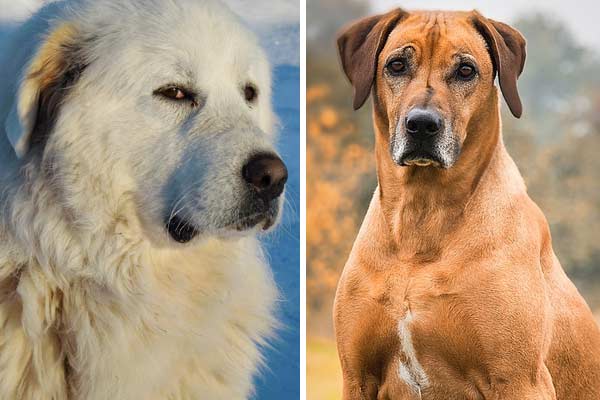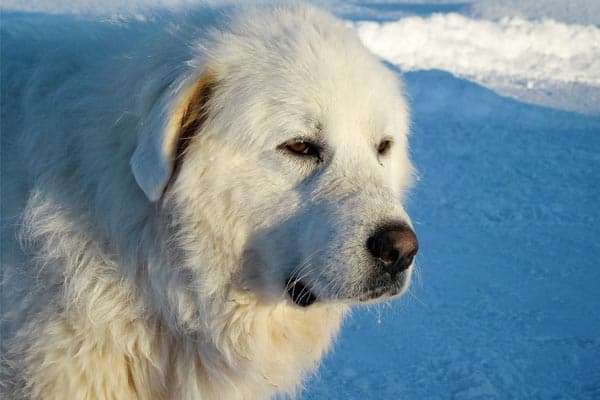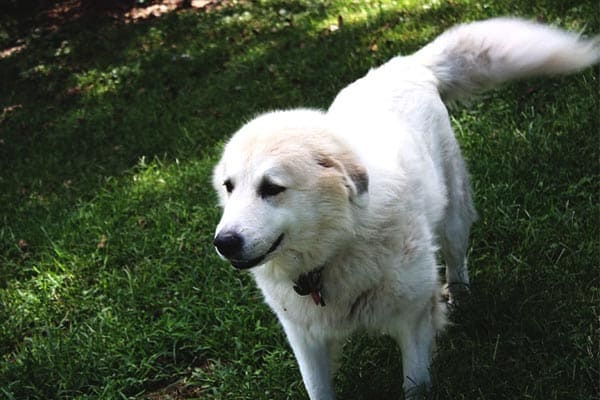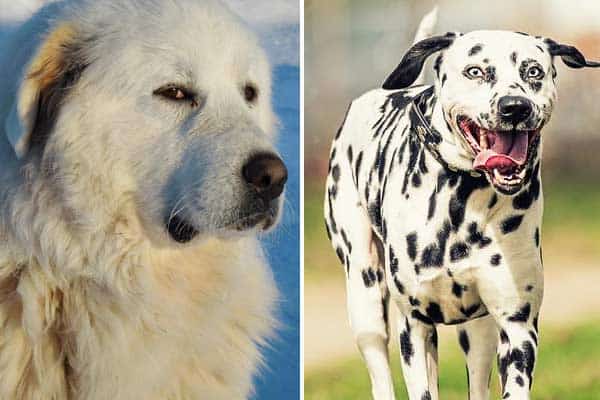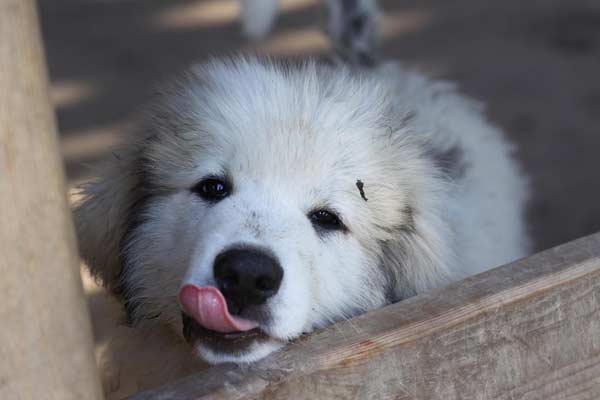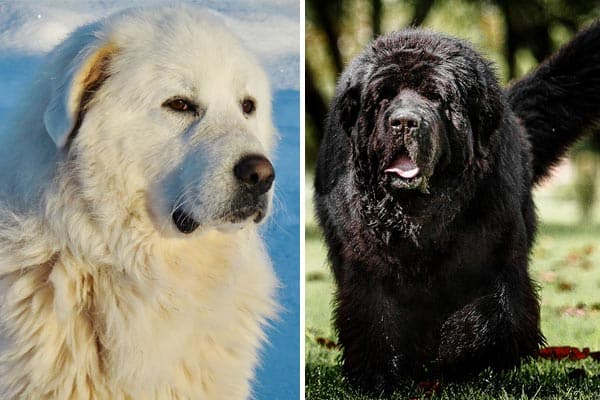Male or Female Great Pyrenees: the Gender Quandary in LGDs and Pets
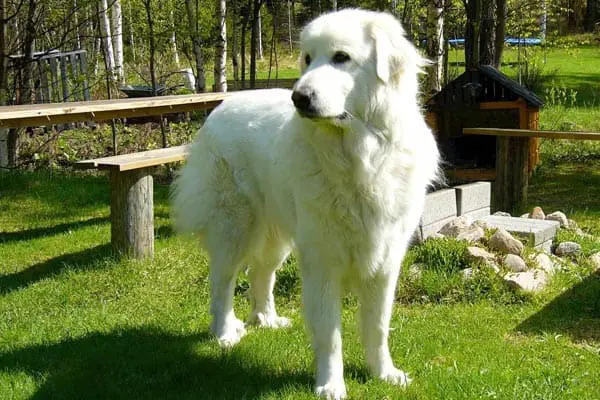
Any time you think about getting a new puppy, it is bound to cross your mind the question of whether you should get a boy or a girl. Sometimes you already have in your mind which one you want.
However, with some breeds, you may wonder if gender makes a difference. With livestock guardian dogs like the Great Pyrenees and guard dogs, many experts, owners, and professionals are convinced that whether the animal is a male or female affects how it works.
Deciding between a male or female Great Pyrenees is largely a matter of preference. While you can make some gender generalizations, what kind of pet a Pyr makes or how well it performs its job boils down to an individual’s personality.
As a rule, males tend to be larger and more territorial, and aggressive while females can be more willful and independent and more inclined to stay closer to the flock. What is clear in all cases is that males and females have different challenges in the field.
Are the stereotypes about male or female Great Pyrenees LGDs true?
A prevailing stereotype is that male Great Pyrenees are typically more aggressive than females. Females are usually pictured as being more nurturing towards livestock.
Males tend to be more territorial.
Because of testosterone, males typically guard their territories more vigilantly than females. This phenomenon is true of many male mammals, not just canids.
What territorialism means for a livestock guardian dog such as the Pyr is patrolling the boundaries of their perceived territory and marking it with urine. Males usually have a larger concept of territory, so they may roam further than females.
You also see an expanded territory as a feature of other males such as deer and big cats. Since males can often breed with several females, it makes sense that one male’s territory overlaps with that of at least a few females.
Gender differences in territorial size are mute with pack animals like wolves. They would of course share the territory and move across it together.
The fact that the female Great Pyrenees has a smaller territory than the male and does not patrol it as often means she typically stays closer to the flock. It can make her seem more nurturing.
Are females naturally nurturing?
As mentioned, female Great Pyrenees typically stay closer to livestock because they do not roam quite as far as males nor spend as much time doing it. While this makes them seem more concerned about livestock and more solicitous, nurturing has more individual than gender influences.
As a breed, the Great Pyrenees of both genders shows a natural affinity for nurturing young animals and children.
Do male or female Great Pyrenees make better livestock guardians?
Again, the personality and breeding of a Pyr are more important than gender in job performance.
Some owners report females are more active and vigilant overall and especially during the initiation of a threat. They could be the first on the scene, so to speak. Males are more likely to await the danger, appearing more relaxed and laidback until then.
Because of their size, males will be the more lethal of the two if a physical altercation does occur. However, if you have two or more LGDs, the size of a female is not as relevant.
Males may engage in the pursuit of predators or human intruders over a longer duration and distance than females. Individual differences do occur where females are territorial pursuers and males are more solicitous nannies. However, each of the sexes comes with predictable challenges.
Male Challenges
Males are typically more aggressive than females in many situations that are not relevant to the task at hand. They also can be more difficult to handle for a novice.
- Can be dog aggressive, especially against those of the same gender
- May become distracted seeking females
- A female in heat can affect job performance and increase fighting between male dogs
- A male dog looking for a mate will roam even further than usual and test barriers to a greater extent
- Aggressive play – growing pains of LGD young male aggression can be the death of smaller livestock like chickens or ducks
- Mark territory aggressively
Female Challenges
The female Great Pyrenees has a few issues you must recognize before acquiring one for your sheep or other pasture animals.
She will come into heat roughly twice a year when she matures. Each cycle lasts approximately three weeks, during which she will be receptive to males for about five to seven days.
If she lives outside, working, you will not have to worry about a mess. However, she can be distracted by trying to find a mate.
What is often worse is that a dog in heat will attract unwelcome male canids from a mile or more within her vicinity. If you have working males along with your female, you may have to contend with serious fights.
Also, if your female does not breed with a male on the farm, you will have a litter of mixed-breed unwanted puppies.
Livestock guarding dogs developed over centuries to perform their jobs in a specific manner, and owners notice a negative impact introducing other LGDs let alone a herding dog or one of a nondescript background.
Finally, imagine how high your dismay will be if your Pyr breeds with a wolf which has been known to happen.
Neutered Great Pyrenees
You can decrease the severity of gender-related stereotypical behavior problems by neutering your working dogs.
Spaying a female will eliminate her heat cycles and end the problems related to it. Neutering a male Great Pyrenees will moderate much of his aggression and keep his mind on guarding livestock instead of finding suitable mates.
Contrary to some prevalent sentiments, neutering your Pyr will not detract from his or her performance as an LGD.
The procedure also does not completely desex your dog unless you do it at an exceedingly young age.
Males will still tend to be more territorial and larger than females. Females will continue to stick close by to their flocks, gaggles, or herds.
Without the distraction of raging hormones, you may find your LGD can do his or her job better.
Also, you can cut out reproductive health problems such as mammary tumors, testicular cancer, prostate enlargement, and uterine infections.
Typically, neutered Great Pyrenees make better pets that are easier to train and manage than intact individuals, especially for inexperienced dog owners.
Should you own both genders of Great Pyrenees?
In an ideal pastoral setting with an average to a large-sized flock of sheep, you should have at least two livestock guardian dogs. Despite their considerable expense, many farms or ranches have several Great Pyrenees, Maremma Sheepdogs, or other LGDs.
In cases where you have multiple dogs, mixed sexes tend to work most effectively. Ranchers point out the fact that mixing genders helps them complement each other’s strengths and nullify their weaknesses. Another major factor is to eliminate same-gender fighting which can occur between females as well as males.
If you have intact animals, keeping a breeding pair can decrease the desire to find other partners. This is especially true of the female if there is a male right there when she enters estrous.
However, realize that raising a litter of puppies can be distracting for both males and females. The flock will become secondary to the puppies, especially with the mother.
Should you get a male or female Great Pyrenees as a pet?
As of the 2020s, you are perhaps more interested in getting the Great Pyrenees as a pet rather than a working dog. In that case, should you choose a male or a female?
Again, your personal preference will play a large role in which one you pick. Both make excellent companions and great watchdogs although you will see some generalities expressed of each gender.
A few are true, but many are stereotypes that will not stand up from one dog to the next.
Males are larger than females
According to the AKC, Great Pyrenees males are 27 to 32 inches tall at the shoulders and can weigh 100 pounds or more.
Some are as heavy as 160 pounds. Females, on the other hand, usually top off at 120 pounds. Smaller females may only weigh 75 to 85 pounds. They are typically a couple of inches shorter than the average male.
If you want a big, impressive dog with a magnificent coat and showy mane or ruff, a male will better fit the bill. If you want a more streamlined dog with less hair, you might gravitate more towards a female Great Pyrenees.
Neither works well for apartments, but both can adapt to living indoors.
Size is not extremely relevant to training because you will not be able to manhandle either gender.
Both cope with cold weather and snow with no problem, but they will struggle as temperatures climb over 80 degrees Fahrenheit.
Males are sweeter than females
Although females are sweet, you will commonly hear from dog owners that males tend to be needier and clingier. Such qualities make them seem more loving and dependent.
Males are often described as the more Velcro-like gender in several breeds. The Great Pyrenees is not a clingy breed, but you may notice the males tend to stick closer to their owners.
However, how strong your bond becomes with your Pyr is more related to the personality of the dog and how you use training and time spent with her than the gender.
Females are more attentive to their owners than males
Another stereotype that probably has more of an individual than a gender dependency is that females are more attentive to their owners.
Owners cite males as more standoffish, seeming to belie their status as the sweeter of the genders. However, males can be seemingly more selfish in their motives to some dog owners.
In such an argument, their solicitation of affection does not necessarily make them sweeter than females. It is another characteristic that is likely more related to the dog’s breed and personality than its gender.
Females mature sooner than males
What can be extremely relevant to a livestock guardian dog is when it matures. Males can take several months longer to mature physically and mentally than females.
Whereas a female Pyr might be ready to work with livestock by 18 months old, it could be two years or more for a male.
Females are more difficult to train
Once again, there are wide temperamental differences that supersede gender considerations when training a Great Pyrenees.
However, many owners describe females as the stronger-willed of the two sexes in general. It goes back to females being more independent than males. While this stereotype might be mostly true, you still need to assess the personality of your dog as an individual.
Ironically, many anecdotal stories report females are easier to housetrain than males, perhaps a reflection of the male’s tendency to mark.
In a household of two Pyrs, should you have both sexes?
With pet dogs of substantial size, many experts suggest getting a male and a female if you want to consider two pets. The goal is to prevent rivalry and fighting.
Mixing genders can guard against some fighting, especially with breeds like the Rottweiler that show specific same-sex aggression.
However, other factors besides gender contribute to dogfighting. Some dogs are possessive over food or toys, territorial, or jealous. Others reflect poor human leadership.
Neutering both dogs plays a tremendous role in eliminating hormonal drive as an incentive for fights.
The bottom line is that with proper training and confident and unquestioned leadership, you can have dogs of any gender get along together in your home. Beginners may find it easier, however, to have a dog of each gender and both neutered.
Video
This video illustrates clearly the physical differences between a male and a female Great Pyrenees or Pyrenean Mountain Dog. Both genders are affectionate with the handlers.
The male is taller and bigger with a more luxurious coat. Note the heavy distinct mane of longer fur across the neck and shoulders of the male.
The female is smaller in frame with less fullness in the coat. Note how the trio of Great Pyrenees bond with each other.
